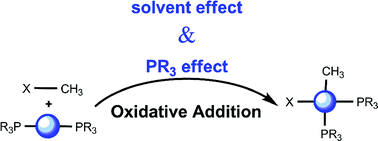Phosphine and solvent effects on oxidative addition of CH3Br to Pd(PR3) and Pd(PR3)2 complexes†
Abstract
The reaction between

- This article is part of the themed collection: Computational chemistry of inorganic systems
* Corresponding authors
a
Institute of Chemical Research of Catalonia (ICIQ), Av. Països Catalans 16, Tarragona, Spain
E-mail:
fmaseras@iciq.es
Fax: +34 977 920 231
Tel: +34 977 920 202
b Universitat Autònoma de Barcelona, Edifici Cn, Bellaterra, Tarragona, Spain
c
University of Tasmania, GPO Box 252C, Hobart, Australia
Fax: +61 3 6226 2858
Tel: +61 3 6226
The reaction between

 Please wait while we load your content...
Something went wrong. Try again?
Please wait while we load your content...
Something went wrong. Try again?
M. Besora, C. Gourlaouen, B. Yates and F. Maseras, Dalton Trans., 2011, 40, 11089 DOI: 10.1039/C1DT10983A
To request permission to reproduce material from this article, please go to the Copyright Clearance Center request page.
If you are an author contributing to an RSC publication, you do not need to request permission provided correct acknowledgement is given.
If you are the author of this article, you do not need to request permission to reproduce figures and diagrams provided correct acknowledgement is given. If you want to reproduce the whole article in a third-party publication (excluding your thesis/dissertation for which permission is not required) please go to the Copyright Clearance Center request page.
Read more about how to correctly acknowledge RSC content.
 Fetching data from CrossRef.
Fetching data from CrossRef.
This may take some time to load.
Loading related content
